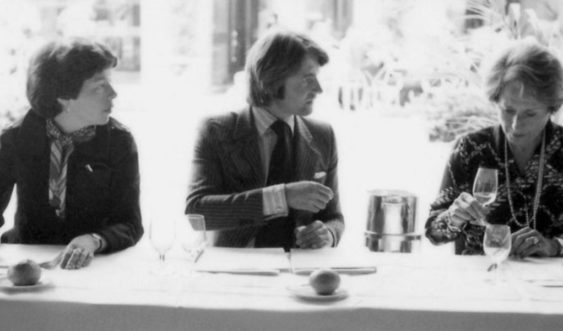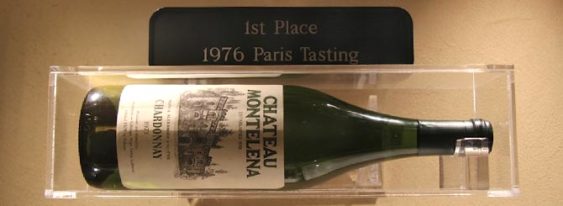Today marks a very special day in the world of wine. May 24, 2016 is the 40th anniversary of the so-called “Judgment of Paris.” Back in 1976, an English wine merchant named Steven Spurrier organized an event called, “The Paris Wine Tasting of 1976.”
Spurrier had a little fine wine shop and tasting school in Paris called Caves de la Madeleine. But he was starting to try the wines coming out of California, and was both intrigued and impressed. So he came up with a novel idea. Why not organize a friendly tasting competition that paired California Chardonnays and Cabernet Sauvignons against their counterparts from Burgundy and Bordeaux?
Spurrier rounded up nine very fancy French wine connoisseurs to be the judges, including the sommelier from the famous Parisian restaurant, La Tour d’Argent, the restaurateur from Taillevent, and wine critic Odette Kahn, who edited the La Revue du Vin de France.

The panel of judges at the original tasting. Photo by Bella Spurrier.
Presumably, this would just be a rhetorical exercise to bring attention to the Californian upstarts, give them a pat on the head when they were totally demolished by the French labels, and send them packing back across the Atlantic. Only, that’s not what happened.
The judges came together at the Intercontinental Paris on May 24 and were given six Chardonnays and six Cabernet Sauvignons from California to taste against four white Burgundies and four red Bordeaux.
The judges tasted them blind, meaning they did not know which wines were from which country as they were tasting them. Here is the list of wines they had on hand, in alphabetical order.
Red Wines
- Chateau Haut-Brion 1970
- Chateau Léoville-Las-Cases 1971
- Chateau Montrose 1970
- Chateau Mouton-Rothschild 1971
- Clos du Val 1972
- Freemark Abbey 1969
- Heitz Cellars ‘Martha’s Vineyard’ 1970
- Mayacamas 1971
- Ridge ‘Mountain Range’ 1971
- Stag’s Leap Wine Cellars 1973
White Wines
- Chalone Vineyards 1974
- Chateau Montelena 1973
- David Bruce 1973
- Domaine Leflaive Puligny-Montrachet 1972
- Freemark Abbey 1972
- Joseph Drouhin Beaune Clos des Mouches 1973
- Ramonet-Prudhon Batar-Montrachet 1973
- Roulot Meursault-Charmes 1973
- Spring Mountain 1973
- Veedercrest 1972
As you can see, there were some real heavy hitters on the French side, and wineries that would become the flag bearers of various California regions on the U.S. side.
Each member of the panel rated the wines in order of quality on a scale of 20. When all the points were tallied up… California wines won. In both the red and white categories!

California wines won both tastings – on the white side, Chateau Montelena Chardonnay took top place.
On the Chardonnay side, Chateau Montelena’s 1973 vintage was the winner, while for the Cabernets, Stag’s Leap Wine Cellars 1973 beat out the best of the Bordeaux. Making this feat even more astonishing is the fact that the Chateau Montelena wine that won was only the second vintage produced by the winery under new ownership and the winemaking team of now-famous Mike Grgich, while the Stag’s Leap wine was made from some very young vines and contained a tiny percentage of Pinot Noir.
Now, the French press didn’t even cover the event, and all of this could have been hushed up with no one the wiser. But it just so happened that a reporter in Time magazine’s Paris bureau had taken a wine appreciation course at Spurrier’s shop a few weeks earlier, and decided to come. And he spoke fluent French.
George Taber was there for the whole tasting, capturing sometimes embarrassingly bombastic quotes from the various judges about which wines they were tasting, and reported on the results. His article was just four paragraphs with no images, but it continues to have a lasting impact four decades later.
International interest in California wines skyrocketed, as did land prices in Napa. New World wines suddenly gained a prominence and respectability they had not enjoyed before. Tastes the world over shifted to favor certain characteristics exemplified by California, and specifically Napa wines. All from a single tasting competition.
If that’s not something to toast to today, I don’t know what is. But let it also be a reminder to all of us to try new wines and judge solely on what we taste. We all might just discover some amazing, new wines that way.

